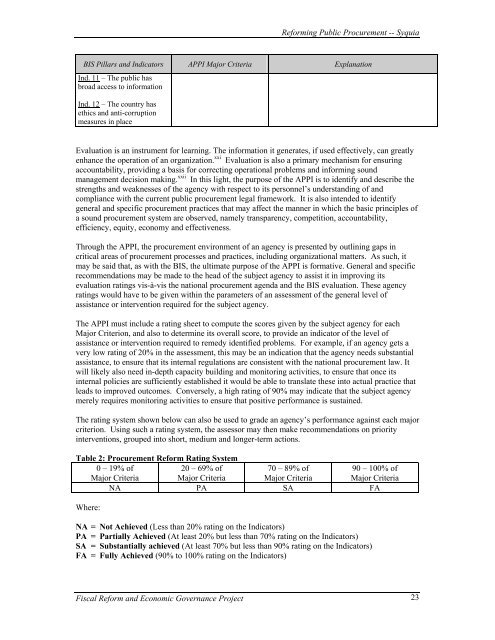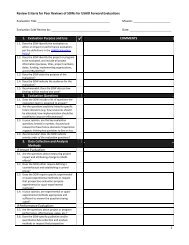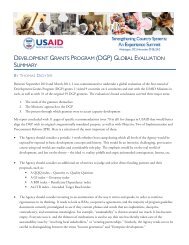Reforming Public Procurement in Emerging Market ... - KDID Portal
Reforming Public Procurement in Emerging Market ... - KDID Portal
Reforming Public Procurement in Emerging Market ... - KDID Portal
You also want an ePaper? Increase the reach of your titles
YUMPU automatically turns print PDFs into web optimized ePapers that Google loves.
<strong>Reform<strong>in</strong>g</strong> <strong>Public</strong> <strong>Procurement</strong> -- Syquia<br />
BIS Pillars and Indicators APPI Major Criteria Explanation<br />
Ind. 11 – The public has<br />
broad access to <strong>in</strong>formation<br />
Ind. 12 – The country has<br />
ethics and anti-corruption<br />
measures <strong>in</strong> place<br />
Evaluation is an <strong>in</strong>strument for learn<strong>in</strong>g. The <strong>in</strong>formation it generates, if used effectively, can greatly<br />
enhance the operation of an organization. xxi Evaluation is also a primary mechanism for ensur<strong>in</strong>g<br />
accountability, provid<strong>in</strong>g a basis for correct<strong>in</strong>g operational problems and <strong>in</strong>form<strong>in</strong>g sound<br />
management decision mak<strong>in</strong>g. xxii In this light, the purpose of the APPI is to identify and describe the<br />
strengths and weaknesses of the agency with respect to its personnel’s understand<strong>in</strong>g of and<br />
compliance with the current public procurement legal framework. It is also <strong>in</strong>tended to identify<br />
general and specific procurement practices that may affect the manner <strong>in</strong> which the basic pr<strong>in</strong>ciples of<br />
a sound procurement system are observed, namely transparency, competition, accountability,<br />
efficiency, equity, economy and effectiveness.<br />
Through the APPI, the procurement environment of an agency is presented by outl<strong>in</strong><strong>in</strong>g gaps <strong>in</strong><br />
critical areas of procurement processes and practices, <strong>in</strong>clud<strong>in</strong>g organizational matters. As such, it<br />
may be said that, as with the BIS, the ultimate purpose of the APPI is formative. General and specific<br />
recommendations may be made to the head of the subject agency to assist it <strong>in</strong> improv<strong>in</strong>g its<br />
evaluation rat<strong>in</strong>gs vis-à-vis the national procurement agenda and the BIS evaluation. These agency<br />
rat<strong>in</strong>gs would have to be given with<strong>in</strong> the parameters of an assessment of the general level of<br />
assistance or <strong>in</strong>tervention required for the subject agency.<br />
The APPI must <strong>in</strong>clude a rat<strong>in</strong>g sheet to compute the scores given by the subject agency for each<br />
Major Criterion, and also to determ<strong>in</strong>e its overall score, to provide an <strong>in</strong>dicator of the level of<br />
assistance or <strong>in</strong>tervention required to remedy identified problems. For example, if an agency gets a<br />
very low rat<strong>in</strong>g of 20% <strong>in</strong> the assessment, this may be an <strong>in</strong>dication that the agency needs substantial<br />
assistance, to ensure that its <strong>in</strong>ternal regulations are consistent with the national procurement law. It<br />
will likely also need <strong>in</strong>-depth capacity build<strong>in</strong>g and monitor<strong>in</strong>g activities, to ensure that once its<br />
<strong>in</strong>ternal policies are sufficiently established it would be able to translate these <strong>in</strong>to actual practice that<br />
leads to improved outcomes. Conversely, a high rat<strong>in</strong>g of 90% may <strong>in</strong>dicate that the subject agency<br />
merely requires monitor<strong>in</strong>g activities to ensure that positive performance is susta<strong>in</strong>ed.<br />
The rat<strong>in</strong>g system shown below can also be used to grade an agency’s performance aga<strong>in</strong>st each major<br />
criterion. Us<strong>in</strong>g such a rat<strong>in</strong>g system, the assessor may then make recommendations on priority<br />
<strong>in</strong>terventions, grouped <strong>in</strong>to short, medium and longer-term actions.<br />
Table 2: <strong>Procurement</strong> Reform Rat<strong>in</strong>g System<br />
0 – 19% of<br />
Major Criteria<br />
20 – 69% of<br />
Major Criteria<br />
70 – 89% of<br />
Major Criteria<br />
90 – 100% of<br />
Major Criteria<br />
NA PA SA FA<br />
Where:<br />
NA = Not Achieved (Less than 20% rat<strong>in</strong>g on the Indicators)<br />
PA = Partially Achieved (At least 20% but less than 70% rat<strong>in</strong>g on the Indicators)<br />
SA = Substantially achieved (At least 70% but less than 90% rat<strong>in</strong>g on the Indicators)<br />
FA = Fully Achieved (90% to 100% rat<strong>in</strong>g on the Indicators)<br />
Fiscal Reform and Economic Governance Project 23







